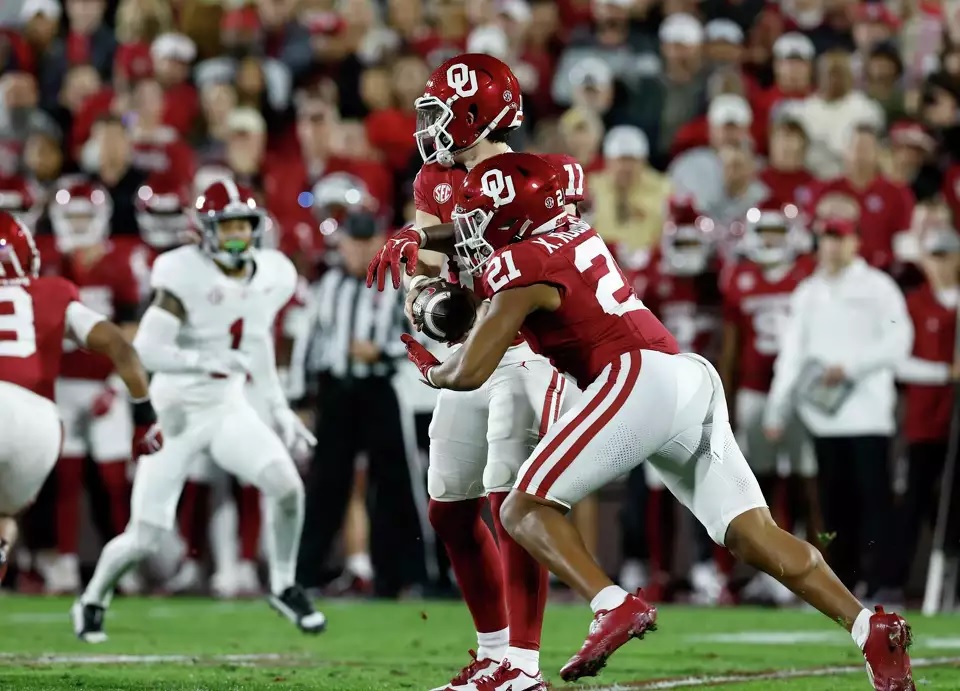
Oklahoma Stuns No. 7 Alabama 24-3: Arnold and Robinson Shine in Historic Upset….
In one of the most shocking upsets of the college football season, the unranked Oklahoma Sooners delivered a resounding 24-3 victory over the seventh-ranked Alabama Crimson Tide. The game, held in front of a boisterous crowd at Oklahoma Memorial Stadium, saw the Sooners capitalize on every opportunity, with running backs Arnold and Robinson leading the charge to the tune of over 100 yards each. The win sent shockwaves through the college football world, as the Sooners handed Alabama their first loss of the season and showcased a performance that was as dominant as it was unexpected.
Setting the Stage: A Clash of Football Titans
The game had been hyped as a potential early-season classic, pitting two football powerhouses against each other in a battle of wills. Alabama, under the leadership of head coach Nick Saban, entered the matchup with a 3-0 record, ranked No. 7 in the nation, and boasting one of the most feared defenses in college football. The Crimson Tide’s offense had been explosive, with quarterback Bryce Young leading a high-powered passing attack and running back Jahmyr Gibbs anchoring the ground game.
Oklahoma, on the other hand, had not lived up to expectations in recent years. The Sooners had gone through a coaching change and were rebuilding under new head coach Brent Venables. They entered the game with a 2-1 record, having already suffered a humbling loss to a ranked opponent earlier in the season. Few expected the Sooners to pose much of a threat to Alabama, especially given the Crimson Tide’s reputation for dominating lesser competition.
However, Oklahoma’s players, particularly running backs Arnold and Robinson, had other ideas. From the opening whistle, it was clear that the Sooners were determined to make a statement.
The Ground Game Dominates
While both teams had elite players in key positions, it was the Oklahoma running game that stole the show. Running backs Jovantae Arnold and Eric Robinson each racked up over 100 rushing yards, controlling the tempo of the game and wearing down the Alabama defense. Their combined total of more than 200 yards on the ground was the driving force behind the Sooners’ success, as they kept Alabama’s defense on its heels and forced the Tide to adjust to a physical and relentless running attack.
Arnold: A Power Back with Breakaway Speed
Jovantae Arnold, a junior out of Tulsa, Oklahoma, had entered the game with modest expectations but left with a performance that would go down in Sooners’ history. Arnold, who was known for his bruising running style and ability to push through tackles, showed off an unexpected burst of speed that kept the Alabama defense off balance. His 14-yard touchdown run in the second quarter was a perfect example of his ability to break free from defenders. Despite Alabama’s defense stacking the box to stop the run, Arnold found a crease and burst through the line, outracing a would-be tackler to the end zone.
“Arnold was simply outstanding,” said Oklahoma offensive coordinator Jeff Lebby. “He ran with power, vision, and the ability to hit the home run. His performance gave us the momentum we needed, and he wore down a defense that is usually very stingy.”
Arnold finished the game with 23 carries for 118 yards and the pivotal touchdown. His performance was a testament to his physicality and determination, as he consistently gained tough yards in critical situations.
Robinson: The Change-of-Pace Threat
While Arnold dominated with his power running, Eric Robinson provided the perfect complement with his speed and agility. Robinson, a senior from Norman, Oklahoma, had been the second option in the backfield but had shown flashes of brilliance throughout the season. Against Alabama, he finally broke through, showcasing his ability to change direction and accelerate through holes in the defense.
Robinson’s most memorable play came late in the third quarter, when he broke free for a 48-yard run that set up a field goal to extend Oklahoma’s lead. With Alabama trailing by just 14-3 at the time, the big play took the wind out of the Crimson Tide’s sails and left their defense scrambling to contain the Sooners.
“Eric is a dynamic player,” said Oklahoma quarterback Dillon Gabriel. “He has the ability to take any run to the house. When he hits that second gear, it’s tough for anyone to catch him.”
Robinson finished with 18 carries for 102 yards, adding a crucial dimension to the Sooners’ ground game. His ability to turn a short gain into a big play kept Alabama’s defense from loading up against Arnold, creating balance in Oklahoma’s offensive attack.
Oklahoma’s Defense: A Wall of Resistance
While the performance of Arnold and Robinson on offense was undoubtedly the story of the game, it was Oklahoma’s defense that allowed the Sooners to build and maintain their lead. Alabama, typically known for its explosive offense, struggled all afternoon against an Oklahoma defense that was playing with intensity and discipline. The Crimson Tide could never quite find their rhythm, and Oklahoma’s defense forced key turnovers and crucial stops when it mattered most.
Stopping the Run
Alabama’s running game, which had been one of the best in the nation, was stifled by Oklahoma’s defensive line. The Sooners’ front seven dominated the line of scrimmage, preventing Alabama running backs Jahmyr Gibbs and Jase McClellan from gaining consistent yardage. Gibbs, who had been averaging over 100 yards per game, was limited to just 42 yards on 15 carries. The Alabama offensive line, typically known for its dominance, was overpowered by Oklahoma’s defensive front, which was led by senior linebacker Danny Stutsman and defensive tackle Jalen Redmond.
Stutsman, in particular, played with an edge, making several key stops in the backfield and providing leadership throughout the game. His ability to diagnose plays and react quickly was instrumental in limiting the Crimson Tide’s success on the ground.
“I felt like we just wanted it more,” said Stutsman. “We knew we had to stop the run to give our offense a chance, and our guys up front were incredible. They were in the backfield all day.”
Aerial Defense: Shutting Down Bryce Young
While Alabama struggled to run the ball, they also found little success in the passing game. Bryce Young, the talented Heisman Trophy-winning quarterback, was harassed all game by Oklahoma’s pass rush and made some uncharacteristic mistakes. Young, who had been known for his poise and ability to make pinpoint throws under pressure, was forced into several errant throws and an interception late in the game.
The interception, which came in the fourth quarter with Alabama down 17-3, was a critical turning point. Oklahoma cornerback Gentry Williams made an athletic play, jumping the route and securing the ball with Alabama driving deep into Sooner territory. The turnover effectively sealed the win for Oklahoma, as they were able to run out the clock and force Alabama to abandon any hope of a comeback.
“You don’t usually see Bryce make those kinds of mistakes,” said Oklahoma head coach Brent Venables. “We were able to get pressure on him, and that was the key. Our guys stepped up and executed the game plan to perfection.”
The Turning Point: A Strong Second Half
The game remained close through the first half, with Oklahoma holding a 10-3 lead at the break. However, the Sooners came out of the locker room fired up and quickly took control in the second half. The defense continued to stifle Alabama’s offense, while the running backs, Arnold and Robinson, kept moving the ball down the field with ease. The key to the game was Oklahoma’s ability to dominate time of possession, keeping Bryce Young and the Alabama offense off the field for extended periods.
Oklahoma’s offense put together a 13-play, 75-yard drive midway through the third quarter, chewing up more than seven minutes of clock and culminating in a 30-yard field goal by Gabe Brkic to give the Sooners a commanding 17-3 lead. The drive was a perfect example of the balanced attack that had confounded Alabama all game.
By the time the fourth quarter rolled around, Alabama had no answers left. The Sooners continued to pound the ball with Arnold and Robinson, draining the clock and keeping the Alabama offense on the sideline. With the game winding down, Oklahoma sealed the victory with another field goal, extending the lead to 24-3.
The Aftermath: A Statement Win for Oklahoma
As the final whistle blew, the Oklahoma sideline erupted in celebration. The upset, which few had predicted, was one of the biggest victories in recent memory for the program. For head coach Brent Venables, it was a sign that the Sooners were on the right path after a tumultuous rebuilding process.
“This is a huge win for our program,” Venables said after the game. “Our guys believed in themselves, and we executed the game plan to perfection. I’m so proud of the effort from everyone involved, especially our players. This is a testament to their hard work and determination.”
For Alabama, the loss was a humbling defeat that would force the team to regroup. Nick Saban, ever the perfectionist, acknowledged that his team had not played up to their usual standards.
“We didn’t execute, and we didn’t play with the physicality that we needed to,” Saban said. “Oklahoma took it to us, and we have to learn from this. We’ll bounce back, but today wasn’t our best effort.”
Looking Ahead
As Oklahoma celebrated one of the biggest wins in program history, the implications of the victory were clear. The Sooners had announced themselves as a serious contender in the college football landscape, and the upset over Alabama would reverberate throughout the season. With a balanced offensive attack and a defense that had proven it could hang with the best, Oklahoma had the potential to be a force in the Big 12 and beyond.
For Alabama, the loss was a setback, but the season was far from over. With a talented roster and a coaching staff led by Nick Saban, the Crimson Tide would likely use the defeat as motivation to come back stronger in their pursuit of a national title.
As for Arnold and Robinson, the pair had solidified their place in Oklahoma football lore with their dominant performances. Both running backs had shown that they were capable of leading the Sooners’ offense to victory against the best of the best. Their combined effort of more than 200 yards rushing not only helped secure the win over Alabama but also set the tone for the rest of the season.
In the end, Oklahoma’s 24-3 victory over Alabama was a statement that echoed throughout college football, proving that on any given Saturday, anything can happen.





